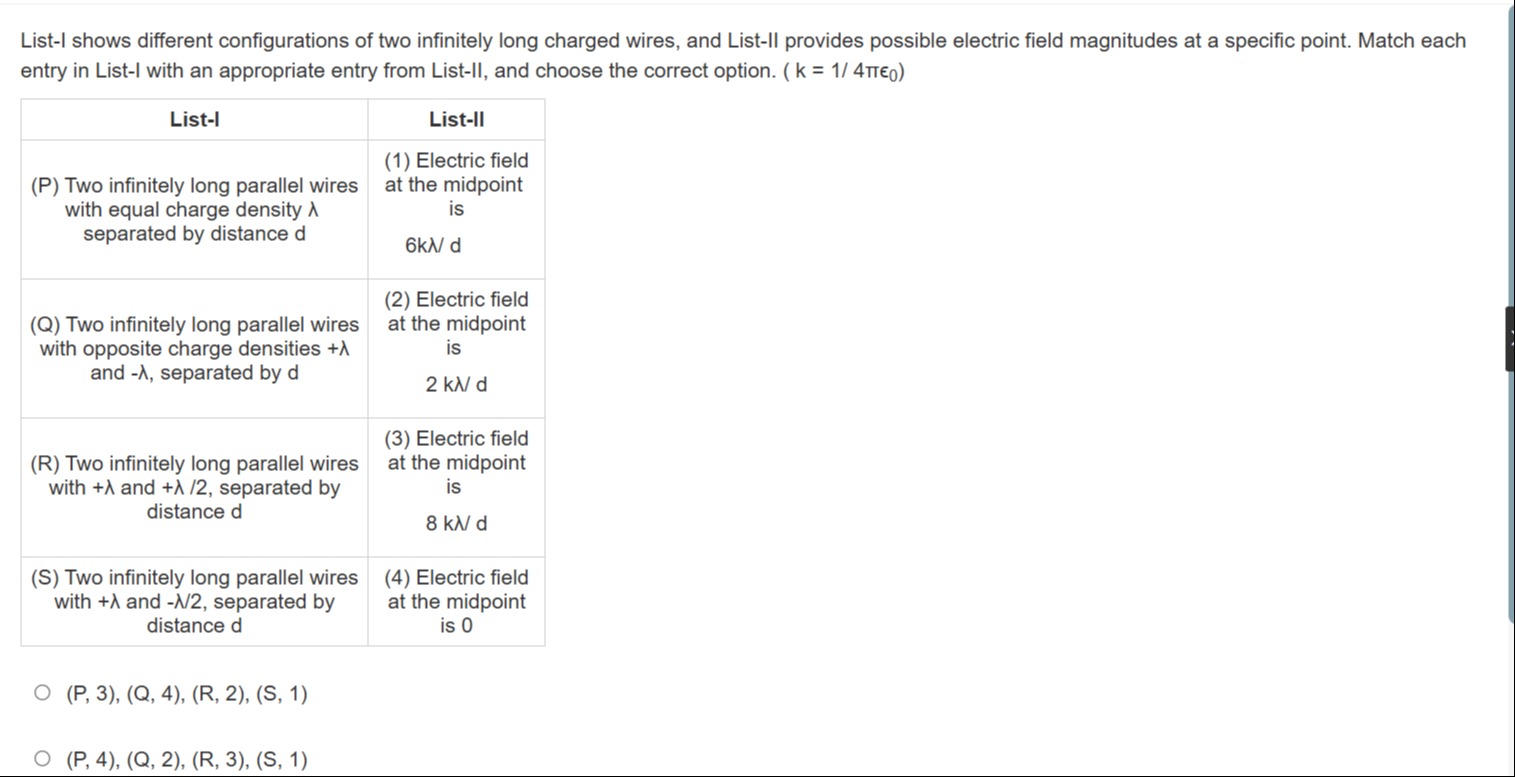Question
Question: List-I shows different configurations of two infinitely long charged wires, and List-II provides pos...
List-I shows different configurations of two infinitely long charged wires, and List-II provides possible electric field magnitudes at a specific point. Match each entry in List-I with an appropriate entry from List-II, and choose the correct option. (k = 1/ 4πϵ0)

Electric field at the midpoint is 6kλ/ d
Electric field at the midpoint is 2 kλ/ d
Electric field at the midpoint is 8 kλ/ d
Electric field at the midpoint is 0
Correct matching: (P) – (4), (Q) – (3), (R) – (2), (S) – (1). Thus, none of the provided options is correct.
Solution
We begin by recalling that the electric field due to an infinitely long straight wire with charge per unit length λ at a perpendicular distance r is
E=r2kλ,
with k = 1/(4πε₀). At the midpoint of two wires separated by distance d the distance from each wire is r = d/2 so that the magnitude of the field from a wire having charge density λ is
E=d/22kλ=d4kλ.
Now we analyze each configuration:
(P) Two wires, both with charge density +λ, separated by d
Place the wires at x = –d/2 and x = d/2. At the midpoint (0,0):
- Wire at x = –d/2 gives a field of magnitude 4kλ/d directed away from the wire → to the right.
- Wire at x = d/2 gives a field of the same magnitude 4kλ/d directed away from the wire → to the left.
Since they are equal and opposite, they cancel. Thus, field = 0 → matches List-II entry (4).
(Q) Two wires with charges +λ and –λ separated by d
Assume +λ is at x = –d/2 and –λ at x = d/2.
- Wire at x = –d/2 (positive) produces a field of 4kλ/d at the midpoint directed away from it → to the right.
- Wire at x = d/2 (negative) produces a field of 4kλ/d, but for a negative charge the field points toward the wire, i.e. also to the right.
They add up:
Enet=d4kλ+d4kλ=d8kλ.
So (Q) matches List-II entry (3).
(R) Two wires with charges +λ and +λ/2 separated by d
Assume +λ is at x = –d/2 and +λ/2 is at x = d/2.
- Wire at x = –d/2 gives a field of 4kλ/d at the midpoint to the right.
- Wire at x = d/2 gives a field of
E=d/22k(λ/2)=d2kλ,
directed away from it (i.e. to the left).
Subtracting (because the fields oppose):
Enet=d4kλ−d2kλ=d2kλ.
Thus (R) matches List-II entry (2).
(S) Two wires with charges +λ and –λ/2 separated by d
Assume +λ at x = –d/2 and –λ/2 at x = d/2.
- Wire at x = –d/2: field of 4kλ/d at the midpoint to the right.
- Wire at x = d/2: field is
d/22k(∣−λ/2∣)=d/22k(λ/2)=d2kλ,
and for a negative charge the field is toward the wire, i.e. from the midpoint to x = d/2, also to the right.
They add:
Enet=d4kλ+d2kλ=d6kλ.
Thus (S) matches List-II entry (1).
Summary of correct matchings:
- (P) → (4)
- (Q) → (3)
- (R) → (2)
- (S) → (1)
Checking the provided answer choices:
- Option 1: (P, 3), (Q, 4), (R, 2), (S, 1)
- Option 2: (P, 4), (Q, 2), (R, 3), (S, 1)
Neither option matches our result (P,4), (Q,3), (R,2), (S,1).
Thus, none of the provided options is correct.
